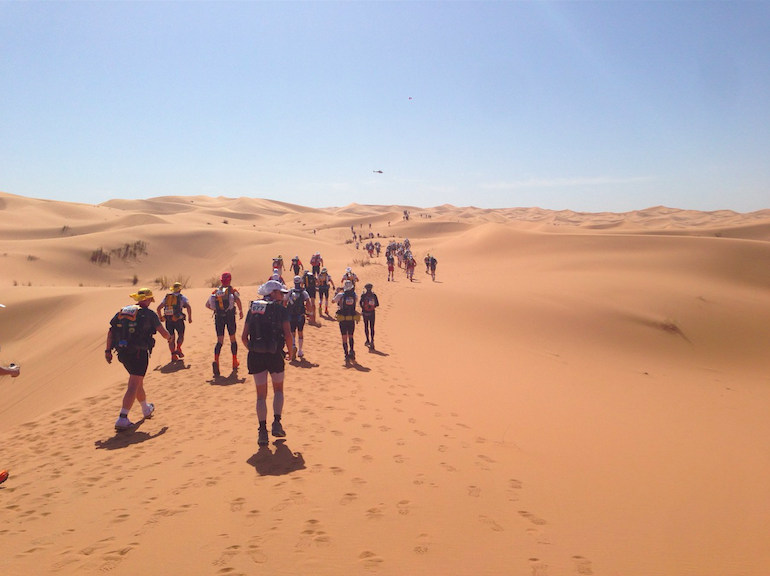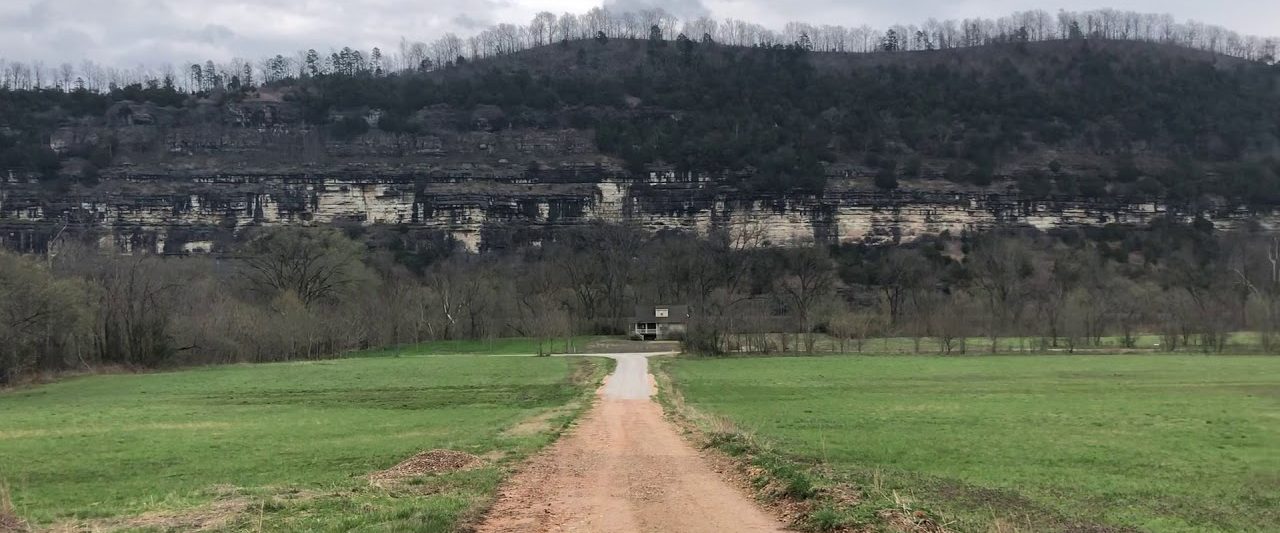
(Blogger’s Note: Brien Crothers of Hidden Valley Lake, CA and I “met” online a few years ago because of mutual interest in the Way of St. James. Just last year we missed one another at the end by only one day. But Brien is much more than your average Camino pilgrim … he’s an extreme athlete with dozens of achievements to his credit around the globe. In November, he’ll tackle the world-famous Marathon des Sables, 155 miles across the deserts of Peru. I asked Brien a few questions as he prepares for this incredible event. Brien has written a book on the Camino de Santiago titled Su Camino… and you can follow his adventures on his blog at grandpasgoneagain.com)
Q: What prompted your interest in outdoor activities like hiking, walking, and running?
A: Growing up in a very small rural community on the north coast of California, in a time when we were encouraged to get outside and play, I knew every kid on my street. Hiking, exploring, fishing, building forts and creating our own toys were how we filled our free time. Also, my father and his four brothers grew up on a ranch where we, as I got older, would get together, usually to trek around in the hills hunting deer. It was great passion for them, less so for me, but I enjoyed and came to respect the outdoors. After our daughter was grown and my career brought better finances, running and cycling put me back in the outdoors.
Q: It seems you’re even more drawn to distance events in extreme conditions. Why not just take an easy walk in the park? Why the extreme?
A: There are two answers to that, I suppose: In my late thirties, I was introduced to a group of people who ran marathons, ultramarathons, and did extreme events like Eco Challenge and serious mountain climbing. For whatever reason, I found myself drawn to the extreme stuff. Now, I jokingly say that I am not a fast enough runner (with a 3:52 marathon personal best), so I do the longer events so my slow pace doesn’t show so badly. Second, and more accurately I think I just don’t want to be average. To look at me in a crowd, I’m average, white, and forgettable. I don’t want to be average.

Q: List for me the extreme or ultra events you’ve participated in.
A: California 1995 Mt Whitney climb*
Several summits of Mt Shasta*
Washington 1996 Mt Rainier climb
Kenya & Tanzania 1998 Mt. Kilimanjaro climb
Peru 2000 Inca trail and Machu Picchu trip*
Viet Nam 2002 Raid Gauloise ten-day adventure (multi-sport) race
Nepal & Tibet 2005 Everest advanced base camp hike, north face of Everest
Russia 2007 Mt. Elbrus climb
South Africa 2010 Cape Epic 440-mile eight-stage mountain bike race
Argentina 2003/4 Aconcagua expedition (unsuccessful attempt to summit)
2009 Aconcagua expedition (unsuccessful attempt to summit)
2015 Aconcagua expedition (unsuccessful attempt to summit)
(Aconcagua is the tallest mountain in the western hemisphere.)
Morocco 2014 Marathon des Sables 155-mile six-stage foot race
Spain 2015 Camino de Santiago via Camino Frances*
2016 Camino de Santiago on Via de la Plata*
Have completed over forty marathon and ultramarathons, including Western States 100-Mile Endurance Run, 3 times (WSER is considered the premier 100-mile trail run in the world).
* = Not terribly extreme, but fun

Q: What are the unique challenges in the upcoming Peru event?
A: The unique challenge of such events is why the organizer has created the race where it is and containing what it does. For Peru and the Ica desert, it’s all about sand and distance. There’s also the route. You can pick just about anywhere for a race and take an easy route or a difficult route. Race officials always find the tough stuff. The required course will direct runners over mountain passes and through vast sand dunes rather than through a valley, for example. To top it off, there’s the 50-mile stage that runs well into the night hours.
Q. Discuss both the physical and mental preparation techniques you use.
A: Physical: Run, eat right, rest, run again. I use a progressive training program. One that builds up mileage requirements over four weeks then is reduced, only to build to a higher weekly mileage in the next wave. This schedule has me running 100 miles per week by the first weeks of November. Mental: I’ve never had much trouble here. I know I’m not likely to win a race, having done so only once (it was a small field), so I go out with a pace I should be able to handle and then adjust up or down as the race unfolds. I have a competitive nature, and use that to push myself harder when I can; I see a runner ahead and start tracking them down.
Q: Speaking of mental and physical, what are the unique challenges you encounter in events like this?
A: Finishing such events is all about managing resources and staying healthy as a result. One must manage water, as it is rationed out at checkpoints; manage to repair, or have repaired, blisters and any other injuries before they become serious, race ending; manage input and output, meaning eat your daily allotment on schedule, and run as hard as your conditioning will allow. It’s all about making it to that last mile and putting out that last bit of stored energy before the finish line.
Q: In what ways does the benefit from these experiences carry over into your every-day life?
A: I’ve come to understand that when we push ourselves beyond normal comfort zones [perceived] hassles of everyday life just don’t seem like a big deal. Our capitalistic society is built on a trance of scarcity, one of lack, and a sense of not being worthy, not pretty enough, not perfect. That’s all bollocks, and we (well, I) need to be reminded of that reality, of my own wisdom.
Q: One thing we share is our experiences along the Camino de Santiago. What are your feelings about the Camino?
A: Wow, that’s a big one. I’m not religious, but something called to me when first introduced to the Camino. On one level the Camino is physical, challenging. On another, it’s adventurous and outside normal life, outside that comfort zone. But, the real reason I have enjoyed every kilometer of the two Caminos I have completed is spiritual. I feel as if I am walking in a peacefulness and calmness that I believe to be the combined traces of energy fields left behind by all those that have taken that path before me, for their cause, in common cause, to find ourselves, to find or be with God.
Q: I’ve always said that everyone knows what it’s like to be tired, but very few know the sensation of complete physical/mental depletion. Would you agree, and can you describe that?
A: I certainly agree that most of us won’t actually dig down to complete depletion. In our modern society we just don’t ever have to go there. Sometimes, when I have been in that state of complete exhaustion but still moving forward, I have experienced some freaky hallucinations. Those occurrences have been like what I might imagine it to be when experiencing hallucinogenic drugs. I have marveled at and enjoyed those experiences, enough so that I look forward to them, but not enough to take the lazy approach.
Q: Not everyone is cut out to be an extreme athlete. What words of encouragement would you have for people who just wish they were in better shape and would like to make some lifestyle changes for the better?
A: It takes some serious self-evaluation to know what your own goals might be. I am driven by accomplishment. The best advice I can give is just get out there and walk. I know a lot of people who haven’t walked more than a few blocks in decades. I don’t get that, but to each their own. For those who do ask me, I’ll ask, what do you want from your question? (I’ve not met anyone ready to do what I do.) Nearly all have said they just want to be healthier. There is nothing easier than walking your way to better health. Start with a city block, then a half-mile, working your way up to whatever works for you and have enough time for. This is very important: do what you can make time for. The key is, consistency. I train six days a week. Five is good. Three is okay. For most people, working up to and walking three miles, three times per week will bring a level of healthiness they haven’t felt in years.
BONUS QUESTION: In the days/weeks following an event like this do you experience a certain emptiness or depression because the lack of intensity and anticipation in your life is temporarily gone?
A: Yes. I always enjoy the reduced urgency to be out there for hours at a time, but I also feel that something is missing, there’s a hole in my day. The best thing for me at that moment is to find the next event. Even if it’s months away, I have something to sink my teeth into.
Q: Is there anything else you’d like to add about your interest in these events?
A: Yes. For several years now, I have been involved at the local level in the American Cancer Society’s Relay For Life. The Relay For Life campaign is one of the most successful fundraisers in America. And, the advisers and students at my alma mater, Middletown High, are the absolute best. Also, staying on the school track and running as much as 100 miles in 24 hours has encouraged others to get involved, to be healthy, to understand the benefits of pushing beyond perceived limits, or at least question their own self-imposed limits. For the Marathon Des Sables Peru, I have partnered up with our local Rotary club (my wife, Kathey, is president-elect of that club) in a campaign called “Polio’s Last Mile” to raise funds for Rotary International’s End Polio Now campaign—to finally eradicate polio from our world.
From a recent article in local papers: “Rotary International has been instrumental in collective efforts around the world to put an end to the dreaded disease that once crippled 35,000 children a year, in the US alone. The Rotary Club of Middletown has long been active in raising funds toward that end.” Year to date, there have been nine reported cases worldwide.
Rotary International and the Gates Foundation with a two-for-one fund match are making a big push this year, because “We are this close.” #poilioslastmile
-30-
